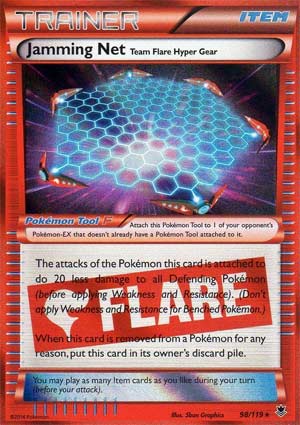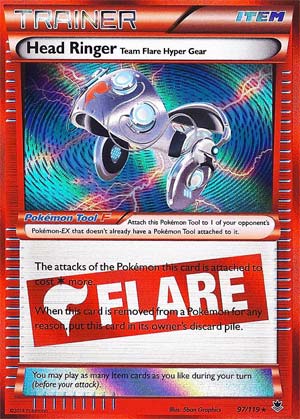|
|
We have both a tie
and a twofer to begin this week. The 14th and 15th
place cards received the same number of voting points
(the tie), but that is not the reason for the
double review. Instead we are looking at two
closely related cards that seemed kind of silly to view
separately. With Manectric-EX and M
Manectric-EX
last Tuesday it was because both cards had met or exceeded expectations
and proven competitive. Don’t assume that is the
case here. So 15th place is shared by Head
Ringer Team Flare Hyper Gear (XY: Phantom Forces
97/119) and Jamming Net Team Flare Hyper Gear
(XY: Phantom Forces 98/119). I’ll just call
them Head Ringer and Jamming Net for the
rest of the review, but I like starting things off
officially. We’ve looked at both of these before:
Head Ringer was reviewed once
normally
and then re-reviewed as the 7th best card of 2014
a month later,
while Jamming Net was reviewed as our
9th place pick
for the top cards of XY: Phantom Forces but never
re-reviewed. The red border “FLARE” stamp behind
the effect text indicate this is a Team Flare card…
except these two are the only cards with it, even though
there are several Team Flare inspired cards that have
neither (like Team Flare Grunt). Go figure.
These are Trainer cards, Items, and Pokémon Tools;
examples of cards that care about this are Skyla
and Trainers’ Mail (work on Trainers), Ghetsis
and Korrina (work on Items), and Eco Arm
and Tool Scrapper (work on Pokémon Tools).
So these cards
share the same core card class, the same subclass, and
the same sub-subclass… and it goes one step further
(sub-sub-subclass) as these cards are a special kind of
Pokémon Tool the game officially labels as “Pokémon Tool
F”, below the card art. Instead of attaching to
one of your own Pokémon, you may only attach a
Pokémon Tool F card to one of your opponent’s
Pokémon-EX. This is one of the few (perhaps the
only) examples of one player’s cards being placed on
your opponent’s side of the field, “attached” to one of
the other player’s cards. This is probably why the
cards have the bright red borders and stamp, since
mixing cards can make it easy to someone to walk away
with one of the other player’s cards (whether accidental
or intentional). There is also another thing
unique to them; their effect text makes it clear that
when a Pokémon Tool F leaves play, it goes to the
owner’s discard pile. Doesn’t matter if the effect
in question would normally bounce the Tool to a player’s
hand, move it to another Pokémon, etc. it will instead
be sent to the owner’s discard pile: yet another
precaution to avoid people having cards lost or stolen
since this is one of the few times players directly mix
cards. Being on your opponent’s side of the field
has some other consequences as well: learn to read the
wording of effects that apply to Pokémon Tools
carefully, because many specify which player’s Pokémon
or which side of the field. For example,
Startling Megaphone cannot spare your own Pokémon
Tool F cards when you use it against your opponent and
it cannot free your own Pokémon-EX if your opponent has
attached a Pokémon Tool F card to it.
So what do each do?
Head Ringer increases the attack costs of the
Pokémon equipped by [C]. Sometimes this will be
meaningless; your opponent had another reason that would
have led to them overpaying anyway, like boosting the
damage output of an attack that scales with your
attached Energy. Most of the time though it
matters; either your opponent won’t be able to attack at
all because they cannot meet this new attack cost or
they can but now they have to invest extra resources
they would have used elsewhere. Jamming Net has
received an erratum because it was originally worded
incorrectly. According to the official Pokémon TCG
errata document it should now read as
The attacks of the Pokémon this card is attached to do 20 less
damage to each of the opponent’s Pokémon (before
applying Weakness and Resistance). (Don’t apply Weakness
and Resistance for Benched Pokémon.)
So this Tool should
only affect the
 damage being done
to the other player’s Pokémon, not (for example)
self-damage, which makes Jamming Net better
because the vast majority of the time you did not want
to help your opponent reduce self damage. If a
Pokémon with a Jamming Net attached hits multiple
Pokémon for damage, the damage done to the other player
(the player who used Jamming Net) will all take
20 less damage. For example if a Landorus-EX
with a Jamming Net uses “Hammerhead”, the attack
will do 10 to the opponent’s Active and 10 to a Benched
target (before other effects) thanks to Jamming Net. damage being done
to the other player’s Pokémon, not (for example)
self-damage, which makes Jamming Net better
because the vast majority of the time you did not want
to help your opponent reduce self damage. If a
Pokémon with a Jamming Net attached hits multiple
Pokémon for damage, the damage done to the other player
(the player who used Jamming Net) will all take
20 less damage. For example if a Landorus-EX
with a Jamming Net uses “Hammerhead”, the attack
will do 10 to the opponent’s Active and 10 to a Benched
target (before other effects) thanks to Jamming Net.
There is another
benefit provided by both cards that is almost as
important as their specific effects; this blocks your
opponent from attaching a Pokémon Tool to that
Pokémon-EX. With the exception of M Tyranitar-EX,
the only Pokémon-EX that can have multiple Tools
attached thanks to its “Θ Double” Ancient Trait, this
shuts that Pokémon off from any intended Pokémon Tool
support completely. If you slap Jamming
Net onto an Yveltal-EX not only will it do 20
less with its “Evil Ball” and “Y Cyclone” attacks, but
your opponent cannot drop a Muscle Band or
Fighting Fury Belt on it. This effectively
reduces the damage done by 40 if Muscle Band was
the go-to Pokémon Tool or by 30 and the HP by 40 if
Fighting Fury Belt was your opponent’s plan. Keldeo-EX
is famous for comboing with Float Stone; this
allows its “Rush In” Ability to approximate a free
Switch once per turn. Slap either
Pokémon Tool F onto Keldeo-EX, and that combo
isn’t happening unless your opponent can ditch said
Pokémon Tool F. Mega Evolutions are both better
and worse off than regular Pokémon-EX; usually a player
is running enough Spirit Link to promptly play
one down, and so their Mega Evolution would be protected
from a Pokémon Tool F (except for Tyranitar-EX/M
Tyranitar-EX). If a player does not get
that Spirit Link down in time, your opponent can
slap a Pokémon Tool F card down and now not only do you
have to deal with attack costs increased by [C] or
damage dropped by 20, but you’ll have to forgo Mega
Evolving or do so at the cost of your turn ending
immediately.
Now it might seem
like an easy thing to block; as stated most decks run
their own Pokémon Tools, so just play yours down
before your opponent can slap a Pokémon Tool F onto any
of your Pokémon-EX (or at least the ones you care
about). The catch is that Pokémon Tool F cards
released alongside Xerosic, with Startling
Megaphone and Tool Scrapper already being
legal; in the prior Standard format only Tool
Scrapper was absent. Startling Megaphone
clashes a bit with Pokémon Tool F usage because it would
discard your own Pokémon Tool F cards, but it enables a
catch-22 to use against your opponent; if he or she
plays down Pokémon Tool cards to block your Pokémon Tool
F cards, there is a risk you just discard those Tools.
This is bad enough if you barely got to use your, say,
Muscle Band but it can be devastating if it was a
clutch Float Stone or Spirit Link card
your deck basically needs to function. All of this
before combos to make Pokémon Tool F cards
stronger. Additionally, if your opponent goes
first and you open with some Pokémon-EX, he or she has
first dibs at attaching and there is likely nothing you
can do about it.
So what are the
combos to which I alluded? One-sided Item lock
means a player loses out on probably the two (and a
half) the easiest way to protect themselves from Pokémon
Tool F cards. Though I just explained the risks,
getting your own Pokémon Tool down is the best method so
long as it’s a Tool you can make use of immediately
(that’s one). You can use Tool Scrapper to
discard up to two Pokémon Tools in play; unlike
Startling Megaphone it can hit your own side of the
field (that’s two). The third best trick is to use
the combination of Battle Compressor, VS
Seeker, and various Supporters (AZ,
Cassius, Xerosic, etc.) that either discard a
Pokémon Tool or create an effect that causes a Pokémon
Tool F to leave the field, triggering its own discard
clause. Obviously you can skip the Battle
Compressor and/or VS Seeker if circumstances
are correct but often enough the card in question
is TecH or a two-of at best (that’s the half).
There are various other ways to protect your Pokémon,
but they are either deck specific, not that good, or
both. So yeah, one-sided Item lock such as through
Seismitoad-EX or Trevenant (XY
55/146) is a potent combo with Pokémon Tool F cards.
In fact, most forms of disruption work well with them;
Energy discarding effects partner especially well with
Head Ringer. There are also various
attackers, like Manectric-EX that get a bonus for
hitting something with a Tool attached. Yes, I’m
being pretty general here; this isn’t that complex and
if you’ve got even a few months of experience in
Expanded (or Standard prior to rotation), you’ve
probably run into this already.
Head Ringer
proved far better than Jamming Net, however going
into it I had the opposite expectation. Card pool
matters, though it may also have just been an oversight
on my part. Thinking of attackers like Landorus-EX
or the decks that had good Energy acceleration,
Jamming Net may only drop damage a little, but it
seemed more reliable; it isn’t that big of a deal to
slap a Head Ringer on Black Kyurem-EX (BW:
Plasma Storm 95/135) when your opponent was just
going to drop an extra Water Energy on it through
“Deluge”, since that was the point of running it with
Blastoise (BW: Boundaries Crossed 31/149;
BW: Plasma Storm 137/135; BW: Plasma Blast
16/101). Instead decks like those began to fade
while competitive decks began to run fewer and fewer
Energy; they also began to run more Energy removal so
decks using Head Ringer had that combo handy
while decks trying to resist Head Ringer had less
Energy with which to power through.
Control/disruption decks made great use of Head
Ringer, as did a few like those focused on
Manectric-EX. Said decks usually didn’t have
room for Jamming Net as well; just too many other
cards to include.
So why would either
or both Pokémon Tool F cards be an important reprint for
Standard? While there are of course non-Pokémon-EX
attackers, a lot of hype has been given to Mega
Evolutions. We also lost the best tricks for
dealing with Pokémon Tool F cards; the two together
could really mess up certain decks while Pokémon Tool F
cards can fit into almost any deck. Of course,
with no easy Tool removal it also means your opponent
can more effectively block them with regular Pokémon
Tools, so it isn’t perfect for Pokémon Tool F cards.
You will still see these being used in Expanded, mostly
in control/disruption decks where their effects can be
maximized. If you’re able to use XY: Phantom
Forces packs for Limited, these aren’t the greatest
pull but they are wonderful insurance should your
opponent bust out a Pokémon-EX.
Ratings
Head Ringer
Standard:
N/A
Expanded:
3.5/5
Limited:
3.25/5
Jamming Net
Standard:
N/A
Expanded:
3/5
Limited:
3.25/5
Summary:
Head Ringer and Jamming Net are two useful
anti-Pokémon-EX cards that are also good for messing
with Mega Evolutions. They lose a lot of their
combo partners thanks to rotation, but enough remain
that in a format expecting heavy Mega Evolution play and
lacking a good way to discard Tools, they should at
least remain about as useful as they have been, if not
becoming stronger. Head Ringer is going to
remain the better of the two unless we see a
competitive deck arise that can easily afford an extra
Energy attachment and that isn’t also shut down by the
other control/disruption cards that are likely combos
with Head Ringer.
Jamming Net
wouldn’t have made the list at all, save for being
partnered with Head Ringer, however it is largely
a case of two cards competing for a niché use that isn’t
large enough to accommodate them both. They scored
23 voting points as Head Ringer made all three
lists. On my personal list, they took 9th place;
part of me thinks 15th is too low because of the amazing
control combos this enabled and because these are
generic use cards… except they aren’t too generic since
they are Pokémon-EX counters, the lack of Trainer based
Tool removal ends up cutting both ways, and their
best combo buddies also rotated out. 15th place
might be a good fit after all.
|

Zach Carmichael |
Today we are looking at Head
Ringer from the Phantom Forces expansion. Alongside
Jamming Net, this is one of two cards with the
label of Team Flare Hyper Gear. This mechanic
changed the game dramatically by allowing you to attach
these Tool cards to your opponent’s Pokemon. While
Team Flare Grunt saw a reprint via Generations,
sadly Head Ringer did not, so it is unfortunate
that this mechanic was short-lived despite providing
some variety in the game.
By attaching Head Ringer to
an opponent’s Pokemon-EX, the attacks of that Pokemon
cost one Colorless Energy more to use. This is
especially good in Energy removal decks that use cards
like Crushing Hammer and Team Flare Grunt.
Seismitoad-EX decks especially benefit from
Head Ringer, as the combination of locking your
opponent from playing Items and barraging Energy
disruption cards while they struggle to set up and pay
more to attack can be devastating.
I had really hoped that the
Standard format this season would be Phantom Forces-on.
So many great cards were in Phantom Forces, namely
Bronzong, Manectric-EX and M Manectric-EX,
and the Team Flare Hyper Gear cards. Without Tool
removal, Head Ringer and Jamming Net would
have become much stronger and likely staples in most
decks. Yanmega BREAK decks would benefit the most
from these cards, as Yanmega’s Assault Boom
attack deals more damage if your opponent’s Active
Pokemon has a Tool card attached to it. Evolution decks
struggle against hard-hitting, big Basics, so being able
to slow your opponent down a bit by having them attach
an extra Energy is a big deal.
In Expanded, we will continue to
see Head Ringer used in disruption decks like
Seismitoad-EX. A popular variant of this in Expanded
uses Crobat from Phantom Forces, whose “Sneaky
Bite” Ability places 3 damage counters wherever you’d
like when Crobat is put down. Add in
Hypnotoxic Laser for inducing Status Conditions – as
well as Silent Lab for Ability lock throughout
the game – and the deck quickly becomes annoying to play
against. At last year’s US Nationals, the biggest
surprise of the tournament was the infamous Wailord-EX
deck that took the event by storm, with Enrique Avila
making it to the finals but losing to three-time World
Champion Jason Klaczynski’s Seismitoad-EX/Garbodor
deck. The Wailord-EX deck relied on some of the
strategies mentioned above, using cards like Head
Ringer and Crushing Hammer to whittle away
your opponent’s deck until ultimately no cards remained.
Ratings
Standard: N/A
Expanded: 3.5/5
Limited: 1.5/5
Summary: Head Ringer
helped introduce a game-changing mechanic into the TCG,
albeit one that was short-lived in the Standard format.
Though it is now rotated, the card certainly has a place
in Expanded with the likes of Seismitoad-EX and
various forms of Energy denial. In Limited, it does not
have much use unless your opponent happens to get lucky
enough to pull a Pokemon-EX out of their packs;
otherwise it is a useless card since you can’t attach it
to your opponent’s Pokemon.
|





